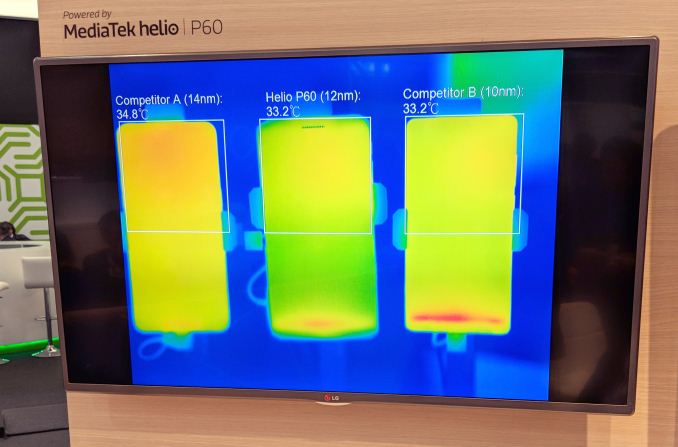MediaTek Announces New Premium Helio P60 SoC
by Andrei Frumusanu on March 1, 2018 9:30 AM EST- Posted in
- Smartphones
- Arm
- Mobile
- Trade Shows
- MediaTek
- Mali
- Helio
- MWC 2018
- P60
- A73
- A53
- ARM Cortex

BARCELONA, ESP – Earlier this week MediaTek announced a new entry in the Helio SoC line-up, the Helio P60. The P60 comes with a strategy change for MediaTek as the company is doubling down on the super-midrange “premium” category and expanding that range into multiple sub-tiers.
The strategy change comes from market and lack of success in the high-end Helio X series. Last year’s Helio X30 had only a few design wins and was relatively late to market. MediaTek seems to have had a string of bad luck with the X20 and X30 as both came on either problematic or very delayed manufacturing process nodes which lost them important design wins. As more vendors switch over to custom designs in the high-end and Qualcomm puts more pressure with competitive designs, MediaTek decided to put a hold on the X series for now and concentrate in the range where it is very successful, the P series.
The this new segmentation means that the P60 doesn’t position itself as direct successor to late last year’s P23 and P30 but rather as a tier above them, hence the naming scheme.
| MediaTek Current P-Series | |||
| SoC | Helio P23 | Helio P30 | Helio P60 |
| CPU | 4x Cortex A53 @ 2.3GHz 4x Cortex A53 @ 1.65GHz |
4x Cortex A53 @ 2.3GHz 4x Cortex A53 @ 1.65GHz |
4x Cortex A73 @ 2.0GHz 4x Cortex A53 @ 2.0GHz |
| GPU | Mali G71MP2 @ 770MHz | Mali G71MP2 @ 900MHz | Mali G72MP3 @ 800MHz |
| APU / NPU / AI Proc. / Neural IP | - | 2x 140GMACs | |
| Memory | 1x 32bit LPDDR3 @ 933MHz 2x 16bit LPDDR4X @1500MHz |
2x 16bit LPDDR4X @ 1600MHz | 1x 32bit LPDDR3 @ 933MHz 2x 16bit LPDDR4X @ 1800MHz |
| ISP/Camera | 1x 24MP or 2x 13MP | 1x 25 MP or 2x 16MP | 1x 32MP or 2x 20+16MP |
| Encode/ Decode |
2160p30 H.264 | 2160p30 H.264 & HEVC | 2160p30 H.264 & HEVC |
| Integrated Modem | Category 6 DL = 300Mbps 3x20MHz CA, 64-QAM UL = 50Mbps 64-QAM |
Category 7/13 DL = 300Mbps 3x20MHz CA, 64-QAM UL = 150Mbps 2x20MHz CA,64-QAM |
Category 7/13 DL = 300Mbps 3x20MHz CA, 64-QAM UL = 150Mbps 2x20MHz CA,64-QAM |
| Mfc. Process | 16FFC | 16FFC | 12FFC |
The P60 is the first SoC in the P-lineup to employ “big” microarchitecture cores as it uses 4x Cortex A73 cores at up to 2.0GHz – a significant performance boost in performance over the P23 and P30’s A53 cores. The efficiency cores are naturally still Cortex A53’s and they run at the same 2.0GHz frequency as the performance cluster.
On the GPU side we see an update in the IP as MediaTek in turn transitions from G71 to G72. The P60 uses a G72MP3 running at up to 800MHz and promises a 25% gaming efficiency boost (at up to 70% higher GPU performance).


Snapdragon 660 vs Helio P60 vs Snapdragon 835 Thermal Comparison @ MWC2018
The P60 is the first mobile SoC to come manufactured on TSMC’s new 12nm 12FFC process node. 12FFC is a shrink of 16FFC and uses the same tools – it’s a cost effective alternative to the more expensive 10FF process which requires quad-patterning. While 12FFC does not quite achieve the die size reduction that 10FF would, it’s extremely competitive in terms of power characteristics and reaches near the same efficiency. I asked MediaTek about the company process roadmap plan and they will focus exclusively on 12FFC for 2018 and have no plans for further 10nm silicon. The next generation will jump directly to 7nm in mid 2019 (after other vendors) when mass production will have reached mature and cost-effective levels.
The P60 is the first SoC to bring dedicated neural network accelerators into the mid-range. MediaTek’s denomination for such IP is APU (AI Processing Unit) so that’s yet another term added to the varied basket of abbreviations from different companies. MediaTek wouldn’t disclose the IP provider but say’s it’s a dual-core implementation offering 2x140GMACs. MediaTek will offer a custom software stack called NeuroPilot which will be compatible with Google’s NN API and frameworks such as TensorFlow, TF Lite, Caffe and Caffe2.
The modem subsystem remains the same as on the Helio P30 – it supports LTE up to Category 7 with 3x20MHz CA and 300Mbps download speeds and Category 13 with 2x20MHz CA for up to 150Mbps upload speeds.
The Helio P60 is in production now and we should see consumer smartphones with the chipset available starting early Q2 2018.










74 Comments
View All Comments
jjj - Saturday, March 3, 2018 - link
Mediatek is not small or medium, they are a giant. Excluding memory and foundry, only a few are larger than them. Intel, Qualcomm, Broadcom, TI, NXP and Nvidia. For any phone SoC above 10$, they will likely go 7nm as soon as possible, it's not like others won't. What they do at 5$, I have no idea.On the GPU side, their options range from Mali, Imagination, Vivante to AMD and Nvidia to in house development.It's up to them to figure out how to get it done and at what cost but they need to, if they are gonna improve their image. Carriers and OEMs might care about the modem but users don't give much of a ... about that.
serendip - Saturday, March 3, 2018 - link
Mediatek is indeed a large company but they play at the bargain basement end of the industry with $50-150 devices in emerging markets. That's a lot of volume to keep them profitable but their attempts to go after the midrange and high end have failed.To me, Mediatek messed up in two areas: perf/watt and UI responsiveness. Snapdragon chips that cost slightly more offer much better perf/watt while also making Android feel snappier.
ZolaIII - Saturday, March 3, 2018 - link
Many enthusiast & volunteers developer eyes & efforts behind CAF made QC's SoC's actually work better. CAF is a last of it's kind after QC killed much better efforts from Texas Instruments and old Broadcomm, Samsung & Huawei tried a bit but it's far behind the open source infrastructure already mature and I'm place from CAF. MTK has none & never even tried to have one at least regarding Android and on Linux it's also a sad story all do some SoC's are there regarding support. QC pushes the clocks beyond reasonable which is a ongoing trend for a long time now regarding the whole industry and only Intel & Apple difference a bit couple years ago but now even them are in the same bandwagon. While everyone else is pushing it beyond reasonable the MTK pushes it to the insane level.jjj - Saturday, March 3, 2018 - link
@serendip That's nonsense. They did not play in high end but they always did in upper mid and bellow. How they compare vs Qualcomm, will differ from SKU to SKU ,from cycle to cycle. Sometimes they are ahead, sometimes they are behind any relevant metric.Qualcomm has larger share today only because they leverage their patents, in legal ways and less than legal ways, to boost chipset sales. They have also been allowed to charge absurdly high prices for their patents, the income before tax from patents almost covers their entire operating expenses on the chip side and that's a very copious free lunch.
If regulators would have done their jobs, allowing Mediatek to compete on product, Qualcomm would be a lot smaller today.
You are clearly impacted by marketing BS but, you should realize that high end is some 20% of the smartphone volumes and the bulk of that is Apple, while Samsung takes the bulk of what's left. That's why MTK has not played in high end, it's risky , costly and limited vols.
MTK messed up last year by not having a 16nm competitor to SD660 and by only having CAT 6 with the octa A53 offering.
Plumplum - Saturday, March 10, 2018 - link
Problem of Mediatek is mainly patents fee on devices over 200dollars.OEM pay fee to Qualcomm even if they use soc from other vendors.
The more the device cost, the more patents fee is important (that's the reason of the War between Apple and Qualcomm)...
That's why mediatek can't sell high-end such as mt6595 or X30.
Intel failed in that way too with Z3580! With a powerfull GPU (Powervr6430, nearly the same that Apple use), and CPU cores that beat Krait on many tasks (JavaScript and HTML5 used in browsers for exemple)
After that Intel stop makingsoc for smartphone!
Patents fee is by far, the first source of benefits of Qualcomm (6.5billions dollars - 600% marging in 2016)
Benefits on soc are far far Lower (1.8billions dollars - 12% marging).
Kftc (Korean fair trade commission) says Qualcomm use patents to sell their soc. They aren't the only one.
In my opinion, the idea that mtk soc are cheaper is false. Mediatek need to make benefits by selling soc. Qualcomm doesn't need to!
Perf/watt, it depends of what you compare...20nm of X20 with 16nm of 820? P2x serie is efficient...at least on some devices.
Responsiveness? Oh! Well used, mtk are quite fast! Despite 20nm process (the same that lead to crappy 810!), X20 is nearly on par with devices that use 14nm
Some soc like S410 and S615 were even ridiculous compare to their competitors mt6732 and mt6752.
Western countries don't see many of them! Mediatek was forced to reduce power on their next generation (mt6735 and mt6753)
Mtk reduce cost on GPU and modem, but CPU part is quite powerfull!
When mtk can't most time reach major OEM, they sell to little compagnies :
- no developpers - no source code - no major updates
- correct CPU/GPU performances but link with other vendors is bad. ISP is badly use...ISP on helio was the first one to be able to treat dual camera effects! Despite these capabilities, some devices shows horrible bokeh effects.
Mediatek's image is linked to these OEM. But Mediatek need them!
ZolaIII - Saturday, March 3, 2018 - link
That's not an answer to the question I asked you & compared to the Samsung & Intel they are tiny, after QC merges PNX in it will also become a same tire as mentioned one's above and by far the largest one fables. With all do respect compared to the really big one's MTK is medium rare all do I am certain that they are concerned about growing over that. I am certain that they will push to 7nm & continue to push insane clock rates but that is exactly the way how to do it wrong. Do you think people really care more about 20% better synthetic benchmarks performance or 20~30% better battery life?Users don't care... about cellular modem as long as it works & LTE bands they need are supposed but still reducing its power consumption (along with every other RF) for 50~75% is something they would greed eagerly much more than Cat XX spread improvements and besides it's becoming necessarily for further move to the 5G.
I will pretend that you answered me on the questions about FD-SOI as (obviously) that you still prefer the FinFET. So I will ask you what do you think about hybrid SOI FinFET's that IBM is going for?
Just if someone else wants to join the discussion hire is one of the recent papers about FinFET, FD-SOI comparation.
ZolaIII - Saturday, March 3, 2018 - link
Supported *The paper:
http://file.scirp.org/Html/1-7601225_76277.htm
jjj - Saturday, March 3, 2018 - link
@ZolaIII Already said this so not sure why I must say it again, consumers are not rational , they buy on marketing and yes vendors need to push stupid high perf instead of rational solutions. Rational solutions are what ruined MTK's image ,creating the "they got slow GPU" rhetoric -you can even see that in comments here from a bunch of folks. Or look at how many think that Apple is ahead in CPU , just because they have a gigantic core pushed to the limit (that nobody needs) and in MT they throttle by like 30%. It's stupid but it's how the consumer is today.On the manufacturing side, I support monolithic 3D and non-volatile switches for brain like devices, I don't particularly care about planar efforts to nowhere- huge efforts for minimal gains, a push that makes no sense and does not enable the solutions the world needs for future devices like glasses, robots, IoT and even future servers.
serendip - Saturday, March 3, 2018 - link
@jjj Slow down on the insults, friend, I'm always a fan of civil discussions even when people disagree.Zola is right on what really matters: user experience and battery life. And no, I didn't swallow Qualcomm BS, I think their patent licensing is stifling the industry but their technical prowess can't be denied.
Mediatek cannot compete on product because their product is behind comparable Qualcomm SoCs. Regulators could level the playing field on the baseband side but the computing side is an open market. Mediatek's only advantage is lower price. Their chips score highly on synthetic benchmarks but they consume 20-30% more power than equivalent Snapdragons. Third party ROM support is also huge on Snapdragons thanks to CAF: Zola is right again on this, no other SoC vendor is as open, and I've sworn never to use Mediatek again after being burned by missing updates on older phones.
jjj - Saturday, March 3, 2018 - link
@serendipThere is no insult, I stated facts, your discourse is clearly one that is heavily impacted by fanboysm and fabricated facts.
"they play at the bargain basement" - false, they try in high end at times and cover everything bellow.
"$50-150 devices in emerging markets|" - again false
"their attempts to go after the midrange and high end have failed." - mega-false, they have dominated mid range for many years and they where close to surpassing Qualcomm in overall smartphone AP units share in 2016 but they had some 20nm and 28nm shortages, then they messed up in 2017.
Then you claim that Mediatek is always inferior and if that's not ridiculous and fanboysm, what is? Qualcomm messes up a lot, they got outfoxed again and again for a decade.
And now you repeat a bunch of the same lies. In 2015 Qualcomm messed up across the board, across the effing board, SD810 and SD615 both melting phones and in low end they lost almost all share. In 2016 they had the horrible Kryo. Late with DDR4 support in mid, last year they forgot support for 18:9. Even the 845 smells wrong, the CPU perf is too low for those clocks, there might be a slight bottleneck in the memory subsystem.
You've seen some review here of a A53 Mediatek clocked high (like the X10) some years ago and you think Mediatek sucks.
Stop with the lies and get your facts straight, that would be the first civil step you could take.